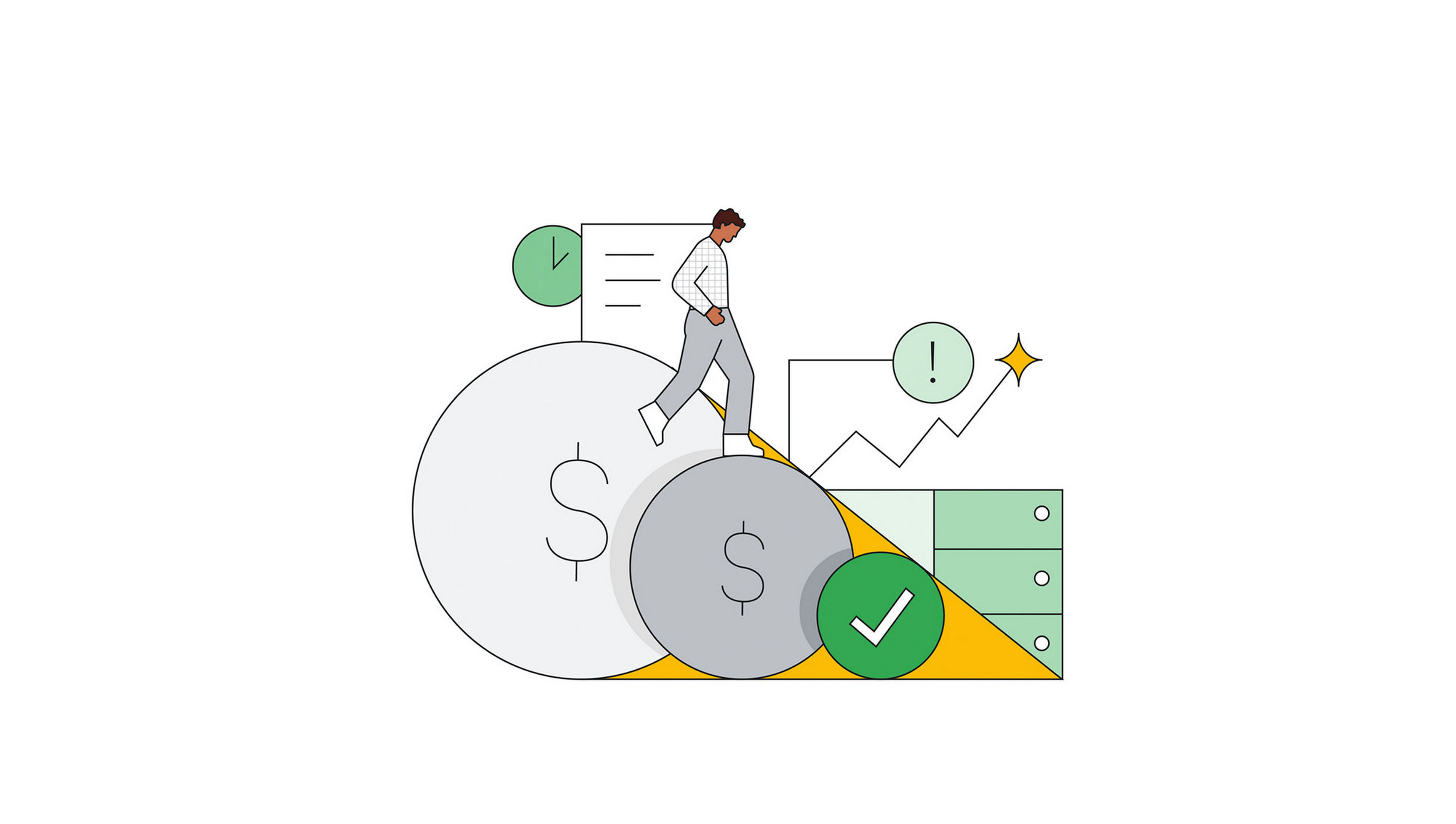Welcome to FinOps from the Field — a new blog series from experienced FinOps practitioners at Google Cloud designed to help answer the most common questions we get here about how you can apply FinOps to your Google Cloud spend. This content will be a combination of stories and experiences designed specifically to help customers on Google Cloud, but for more information about FinOps, check out the overview here or, for a cloud agnostic view, see www.finops.org.
In a world where cloud services have become increasingly complex, how do you take advantage of the features, but without the nasty bill shock at the end?
The State of FinOps 2023 survey cites “Organizational Adoption of FinOps” as the second highest challenge for businesses when looking at FinOps in their business. When you look at the projected billions of dollars in cloud wastage, it’s not a surprise Flexera’s 2023 report shows 82% of respondents’ primary challenge was managing cloud spend.
Here at Google Cloud, Google Professional Services works with both large and small organizations to build FinOps capability through the means of a FinOps Assessment Workshop. Having worked with over 100 customers in these workshops since 2020, the workshop has been iterated on based on customer feedback. By establishing a concrete plan (referred to as the FinOps Roadmap) key stakeholders within a customer’s organization have the ability to answer the difficult question of “Where do we start?”
The FinOps Roadmap is a definitive document of where various business units are assessed to be right now in seven key capabilities, a prioritized list of what the future state should be, and next steps inside each specific capability.
Today’s blog post will go through the steps that Google PSO takes customers through, focusing on our initial discovery and recommendation workshop. By the end of it, you’ll be able to use the information and tools below to build your own FinOps roadmap.
Step 1: Define stakeholders
Before the workshop happens, the process starts with asking the customer to identify specific stakeholders who have or will have cloud spend. These folks can come from any business area. We recommend two to three individuals from the following areas as a good starting point:
-
FinOps/CCoE (if it exists!)
-
Engineering
-
Platform
-
Business
-
Finance
Usually 10-15 stakeholders is the right amount — this ensures that there’s adequate representation from each of the key business units, helps break down silos and keeps the flow of the workshop on track.
The goal of the workshop is to establish how mature the current FinOps capability is right now, and where it needs to be, to support effective scaling of cloud usage with the FinOps roadmap as the agreed output.
Step 2: Define FinOps
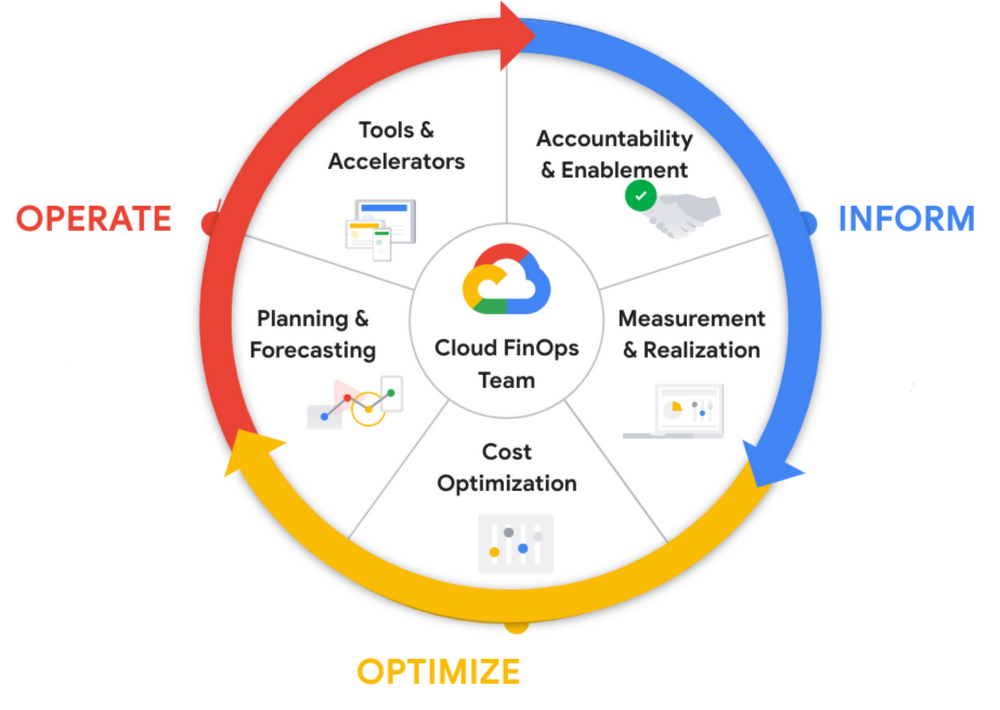
What is FinOps, really? Hint: It’s not just cost optimization!
The workshop begins by ensuring all workshop participants have a shared understanding of what FinOps actually is. There are many misconceptions and definitions out there, but having one definition helps ensure everyone present knows why this is important for their organization.
FinOps is an operational framework and cultural shift that brings technology, finance, and business together to drive financial accountability and accelerate business value realization through cloud transformation.
It’s a model that allows you to understand your Cloud spend, maximize the sustainable parts that generate value, and gives you a robust structure to reduce/eliminate wasted spend.
Running on the cloud is an investment for an organization’s business, and shifting the mindset from how much it costs to how much value it provides allows them to create a roadmap with more than cost-cutting in mind. Reducing waste is important, but not the only purpose of a successful FinOps strategy.
Step 3: Assess against 7 core capabilities
Following this, the group undergoes an assessment which is designed to establish their current maturity state in seven capabilities:
-
Cost allocation
-
Reporting
-
Pricing efficiency
-
Architectural efficiency
-
Training and enablement
-
Incentivization
-
Accountability
We consider these seven capabilities as cornerstones for a minimal viable FinOps practice, and the Crawl, Walk, Run maturity model outlines the next stage an organization can aim for.
These can be adapted and personalized for your own organization, and we define each of these (always starting from a shared understanding) and provide a clear example of what would be considered “Crawl, Walk, Run.”
Let’s review each capability:
1) Cost allocation: The process by which cloud costs are assigned an owner, via the use of labels or tags to be identifiable either for show (“showback ”) or charging (“chargeback”).

Cost allocation is often seen as one of the hardest problems by organizations to solve, and many organizations in the workshops rate themselves as Crawl due to the complexity and pressure of getting it right. We often recommend that customers start small, build their confidence in their tooling and education and iterate their allocation strategy often.
2) Reporting: The process by which allocated cloud spend data is made visible and available for users to see theirs/other departments spend and provide answers to common questions (e.g. “Which application spent the most last month?”).
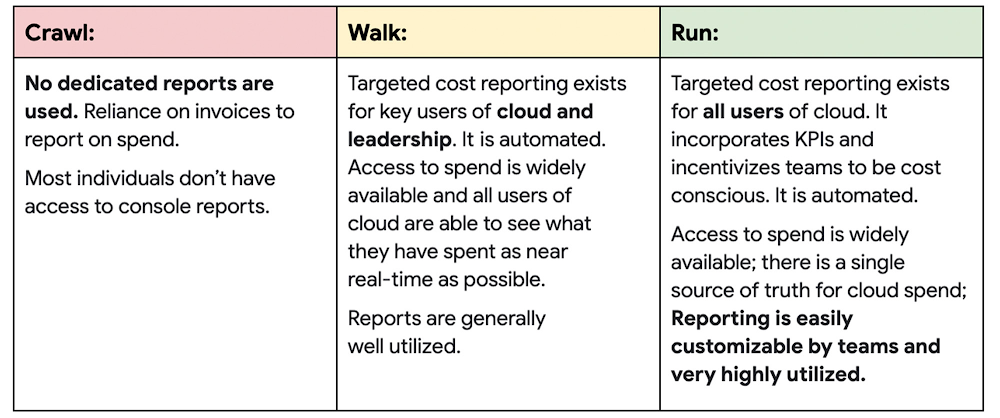
Our findings across multiple customers with Reporting is that many customers are unaware of the Google Cloud tools available in the console, or do not provide access to their teams to access them. More often this is accidental and education/review of the IAM permission model helps them securely provide access to their teams. The built-in tooling can be a great starting point for teams to understand what data is useful and where they need to build customized views.
3) Pricing efficiency : A group of levers to pull to change the end cost of the cloud based on market conditions or special offers (discounts, committed usage etc).
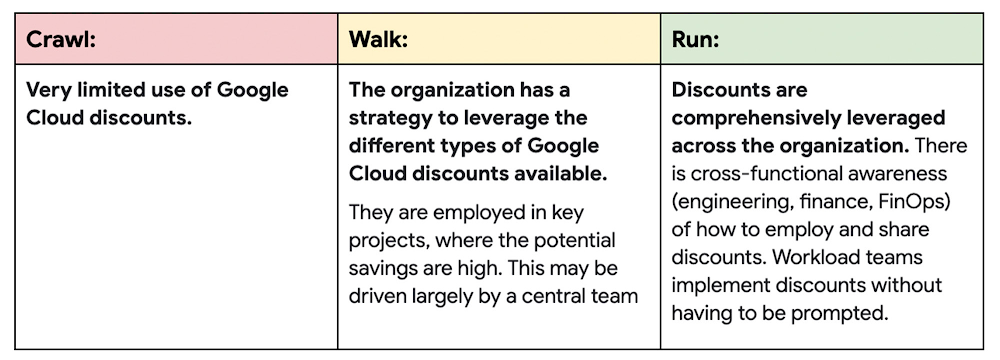
Pricing efficiency is an interesting topic for most organizations and the most likely place for “shadow FinOps” as many teams have started purchasing discounts on their own. Many organizations find this a place for “low-hanging fruit” and add a high priority item on their roadmap to find and consolidate discounts across the organization for the best deal.
4) Architectural efficiency: The extent to which applications are architected for the cloud and make use of the benefits of Cloud pricing.

An interesting finding in workshops is that architectural efficiency is usually forgotten as a FinOps capability because customers report that the move from on-prem to cloud has a larger perceived ROI than any individual application modernization. However, once the initial migration is complete, organizations start to prioritize architectural efficiency and most consider their capability as Crawl.
5) Training and enablement: The extent to which individuals in the organization are upskilled on FinOps.

Training and enablement and incentivization (see below) tend to correlate strongly in maturity with customers. A key roadmap item usually includes a step to consider investment in both capabilities at once to encourage rapid up-skilling.
6) Incentivization: The extent to which employees are motivated to make cost-conscious choices.
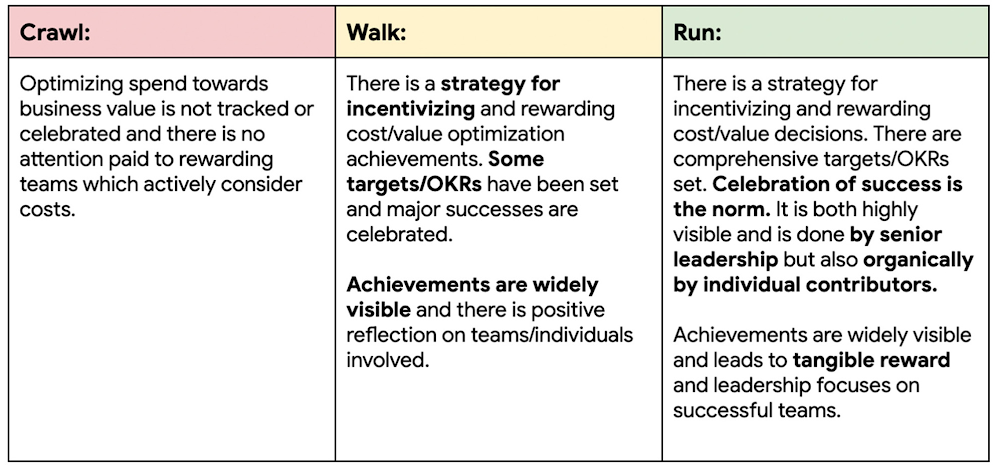
Incentivization is a challenge for many organizations as reported both in PSO workshops and in the wider FinOps community. Here, an outcome to review any budgets for success is often captured as a key next step to ensure continuing funding for incentives as teams up-skill.
7) Accountability: The extent of which a strong culture of ownership regarding cloud spend exists.

There are many other capabilities not covered above (e.g., creating unit metrics, accurate forecasting, internal and external benchmarking, etc.), but these can be established later once foundations are present.
Once all the capabilities have been defined, and any questions clarified about the maturity states, participants are then asked to rate in each of these areas:
-
Where is the organization right now? Crawl, Walk or Run?
-
What’s the 12 month target? What’s realistic? Crawl, Walk or Run?
-
What are the critical success factors to be able to get there?
(A brainstorm of ideas that are then inputs to the roadmap.)
After posing these questions, a lively discussion likely takes place, and the teams walk away with a better understanding of how each capability is seen within different areas of the business, where it is thriving, and where it may need more guidance or investment.
Customers often use this part of the discussion to prioritize concrete next steps culminating in the Roadmap output: Which capabilities are the most urgent, what do individual stakeholders need, and how can the group work in-sync to the defined maturity level of that capability?
If you have a small cloud footprint, and a small set of cloud users, you may find the answers to the above questions don’t require much discovery, discussion or effort to answer.
However, the larger your organization is, the more valuable this exercise is, allowing you to identify different pockets of maturity across your organization. For example, your data and analytics team may have a strong understanding of their costs and how to optimize them, whilst your product teams might have no way of viewing their spend at all!
The key benefit of assessing your capabilities as a group is that you’ll end up with:
-
A common understanding of FinOps across your organization of where you stand against key FinOps capabilities
-
An aligned view across many teams of what should be the next steps
For example, an organization may be currently in the ‘Crawl’ stage of Allocation. Cross-functional stakeholders identify this as a priority for the next 12 months, with an aim to reach ‘Walk’ and to build a robust tagging strategy to cover 50% of their cloud estate.
In this scenario, their FinOps roadmap includes the following steps usually undertaken by a FinOps team:
-
Discuss with finance what the current chargeback model looks like and where there are gaps
-
Discuss what tags would be meaningful for each business unit and how this relates to the model identified
-
Discuss with platform teams where tags should be applied (project/resource)
-
Review the technology that allows the platform team to automate this
-
Provide education and training to engineers to bring tags into their workflow
It’s always difficult to predict the exact output of this workshop, but visibility of spend (via cost allocation and reporting) and defining who is formally responsible for cloud FinOps, are the most common areas of initial focus. A large telco company undertook the FinOps assessment workshop and found some great insights. You can read more about their journey here.
A FinOps roadmap allows the organization to work in an aligned manner, step-by-step to the next stage of maturity.
What next?
Now you’ve taken off the pressure of getting everything right the first time, and built your roadmap. What’s next?
-
Take a deep breath!
-
Review the steps that each team needs to take in that capability to reach the intended maturity state.
-
Use the individual stakeholders from the meeting as ‘FinOps champions’ in specific teams that need to implement the agreed actions.
-
Provide feedback on the new features of the capability internally — celebrate the success!
-
Review, and repeat!
One of the best things about FinOps is its iterative nature — no organization could or should be at the “Run” maturity state when they start out, or even have all capabilities as ‘Run’ as an end goal.
Think of it as a circle: once you’re done with your first cycle, you’re right back at your starting point. This time you hold more knowledge, you’ll develop and further expand your FinOps strategy and have the ability to innovate and thrive.
Don’t panic if this all sounds like a lot, as picking a single area to focus on will bring you further insights into your cloud spend.
In six months, try reviewing your capabilities again. Are you on track to hit those 12 months target(s) you set as a group during the discussion?
Over time, you’ll build up confidence in your FinOps strategy, but we hope this article has given you some pointers on where to start. Join us next time to further your FinOps journey on Google Cloud.
Attributions:
State of FinOps by FinOps Foundation
Adopting FinOps by FinOps Foundation
Flexera 2023 State of the Cloud Report

